Best small gaming motherboards 2023: Picks for Intel and AMD

Intel and AMD’s next-generation platforms are both here, with advanced technology like DDR5 and PCIe Gen 5. That means a plethora of motherboard choices, from frugal options, to the most princely. It also means more options for small form-factor PCs.
After we picked the best gaming ATX motherboards in 2023 in our last roundup, we’ve set our sights on a new goal: finding the best small form-factor motherboards in 2023.
Small form-factor will encompass two main sizes: Mini-ITX, with a diminutive 6.7×6.7-inch (170x170mm) size, and Micro-ATX, with a slightly larger size at 9.6x 9.6-inch. (244x244mm) footprint.
After carefully going over each motherboard and using them in real-world scenarios, we’ll answer the same questions as we would for standard ATX motherboards:
What are the features and specs? Is it an aesthetically pleasing design with robust build quality? How is the performance, and are there any compromises due to size? We’ll also consider how the smaller form-factor means “less space” for features and some tradeoffs versus ATX.
Updated 9/08/23: See our review of the Gigabyte B650M DS3H. This microATX board uses the B650 chipset for AM5 compatibility, while being eminently affordable. It’s a great option for thrifty small-PC builders.
Best small form-factor gaming motherboards for Intel
Asus ROG Strix Z790-I Gaming WiFi – Best premium Intel SFF board
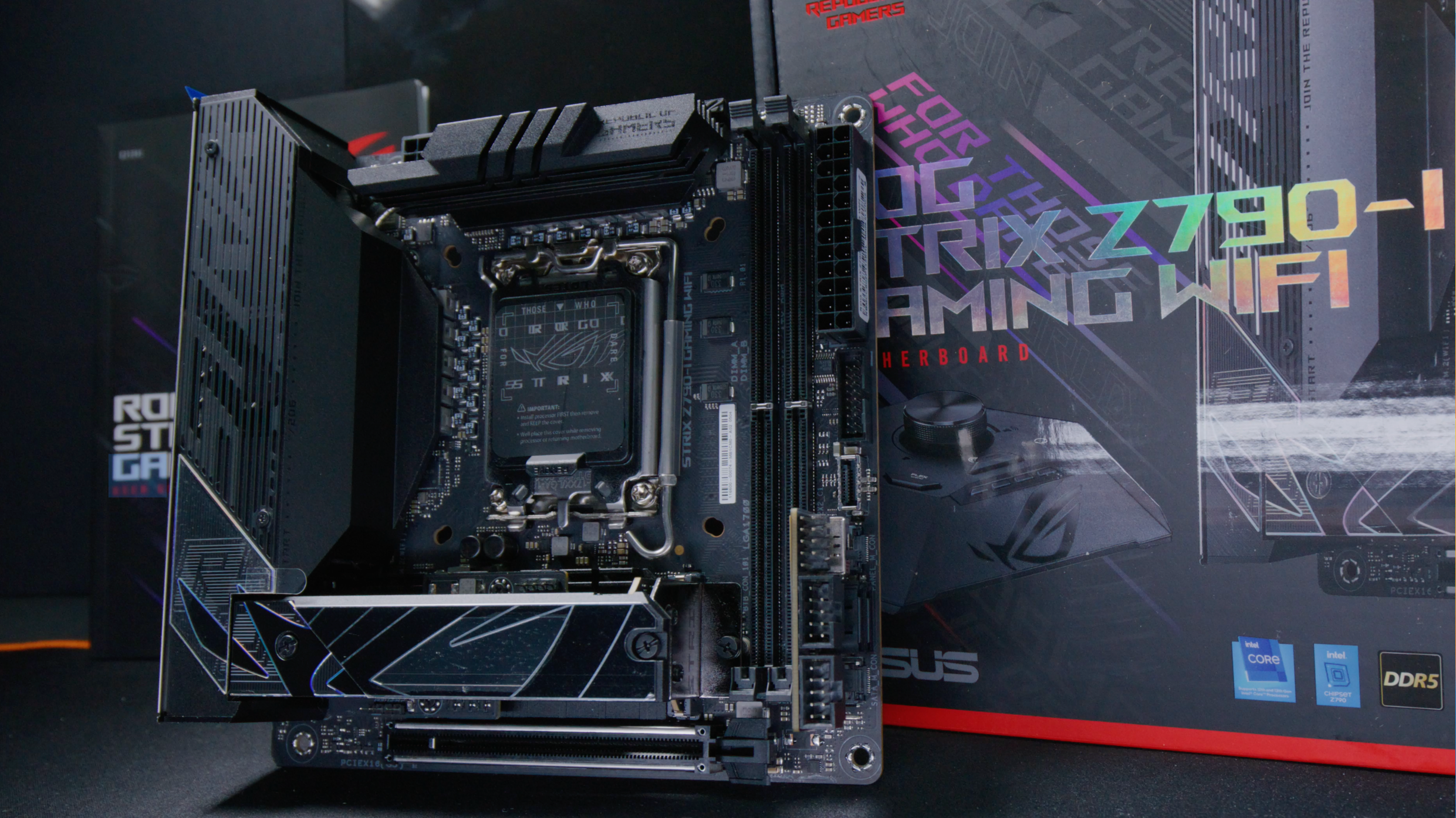
Pros
Overall one of the best available Mini-ITX motherboards Two onboard M.2 slots, Thunderbolt 4, PCIe 16x Gen 5 Solid networking and great audio options with included Strix Hive Enthusiast-approved ROG aesthetics and functional design elements such as Q-Latch for M.2 drives
Cons
$469 MSRP will deter some shoppers Mini-ITX has some inherent limitations due to its size Gamers might find some features unnecessary, such as Thunderbolt 4 Price When Reviewed:$469Best Prices Today:$439.99 at Amazon
You’d like to build a small form-factor PC, but you want that “big” performance? No sweat, the Asus ROG Strix Z790-i Gaming WiFi brings you exactly that. Make no mistake, at $469 MSRP, this is an enthusiast-focused premium offering.
What do you get in exchange? From the moment you open the tiny box, you’ll appreciate the included accessories and premium feel of the experience. You’ll get your usual fare of SATA cables and stickers, but there’s more! You’ll also get a neat external sound device, called the “ROG Hive,” which acts as a little hub. This is great for small builds that can’t fit sound cards or more expansion internally. The “FPS II” card also gives you more SATA ports and headers when connected to the motherboard, a clever way of keeping the important components unaffected while adding more utility in a small package.
The accessories are fun, but you’ll be really impressed with the performance. Robust VRMs with 10+1 power stages should easily handle even the mighty Intel i9 13900K. Keep in mind that you’ll need some heavy-duty CPU cooling for the i9 CPUs, which may be a challenge in a small form-factor build. (You’ll likely want to pair this with a slightly less power-hungry Intel CPU, such as the i7 13700K, if only to save space on cooling.)
Adding to its pedigree is the inclusion of next-generation tech. DDR5 RAM is standard, but keep in mind you’ll be limited to just 2 DIMM slots and 64GB of RAM. That’s one drawback in comparison to larger Micro-ATX or ATX motherboards that typically allow for 4 DIMM slots and 128GB.
The latest PCIe is also here—with a PCIe Gen 5 16x slot for your GPU. Theoretically you can also get Gen 5 speeds on one of the M.2 slots, with some drawbacks: You’ll have to share those PCIe Gen 5 lanes for that to happen, meaning your GPU won’t have access to all 16x. The best solution is to keep the GPU at 16x, and just run the M.2 slots both at Gen 4, which is then fine. (Hard to saturate Gen 5 right now since the hardware is so new.)
The good news continues with the onboard features. Need USB ports? You’ll get a total of nine rear ports! That’s a great number that rivals even some ATX motherboards. If that wasn’t enough, they’re mighty fast, too. You’ll even get two of the rarified Thunderbolt 4 ports for 40Gb/s goodness. They can even serve as display-out ports for monitors, along with the single HDMI-out available on the rear.
For networking, you’ll get 2.5Gb LAN along with Wi-Fi 6E. Bluetooth is also standard, allowing for flexible connectivity. This is akin to many ATX motherboards, so there are virtually no compromises on the networking front. With the included Asus “ROG Hive” external device, you can have a volume dial at arm’s length for quick adjustment.
So it’s feature-packed and performs great—but how about the design aesthetics? It’s a pure-breed ROG, or Republic of Gamers, high-end enthusiast design from Asus. With gorgeous styling, tasteful RGB implementation, it’s one sweet package. While you may not see it much in a small Mini-ITX PC case, the visible parts are sure to impress.
Are there any drawbacks to be aware of? First, it’s certainly a pricey option at $429 for some. You’re also paying for some features that gamers may not always need (such as Thunderbolt 4). It’s also restricted somewhat by its size, compared to a Micro-ATX motherboard or ATX. Fewer RAM slots, PCIe slots, and SATA ports, mainly. Otherwise, it’s a fantastic motherboard for the right user.
It’s not cheap, but if you’re aiming to build one of the fastest Mini-ITX gaming PCs known to gamers, this is a key component that will help accomplish that task.
Read our full Asus ROG Strix Z790-I Gaming WiFi review
Asus ROG Strix B760-I Gaming WiFi – Best midrange Intel SFF board
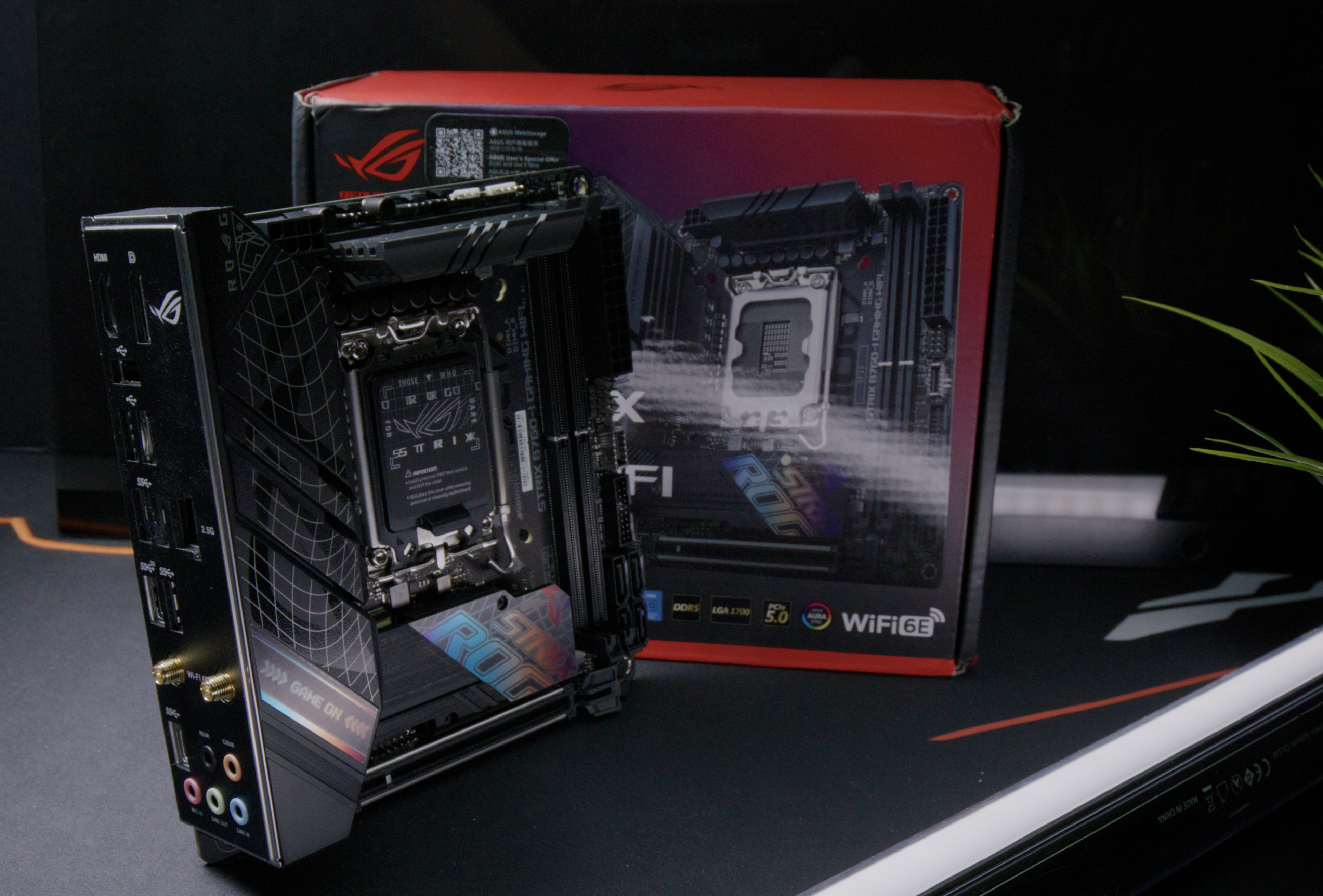
Pros
Great I/O features for Mini-ITX Two onboard M.2 slots, 20Gb/s USB, PCIe 16x Gen 5 Good networking and decent audio Colorful ROG Strix design, integrated I/O shield
Cons
B760 chipset doesn’t take full advantage of Intel 13th-gen such as having more PCIe lanes Not for CPU tinkerers and overclockers Price When Reviewed:$219.99Best Prices Today:$199.99 at Amazon
If you’re after a small form-factor build and want a good balance of features for the price, The Asus ROG Strix B760-I Gaming WiFi is a worthy choice. Coming in at $219, it is significantly cheaper than its Z790 counterpart, but with some notable drawbacks.
While both boards are Mini-ITX, this motherboard is wrapped in the B760 Intel chipset instead of Z790. That means a lack of real overclocking support—we’d avoid most of the “K” Intel SKUs such as the 13900K. You’re likely to use something like an Intel i5 13600, which will have less power draw and heat. Both are advantageous in a small form-factor build!
B760 also gives you less VRM cooling in general, to go in line with the more efficient CPUs. You’re also more limited with theoretical PCIe lanes, SATA ports, and USB ports. This isn’t as much of a factor since Mini-ITX already sets a cap of many of these items due to size.
If some of those drawbacks are acceptable to you, there are many positive features to find here. While the included accessories don’t include novelties such as the “ROG Hive,” they also add to the cost. You’re still getting all of what you need here, like a Wi-Fi antenna, SATA cables, etc.—and nothing that you don’t.
Most importantly, performance with most CPUs will still be stellar, even with the 8+1 power stage VRMs. You’re still getting access to DDR5 RAM, albeit the same two-slot limit as on any Mini-ITX motherboard at 64GB.
PCIe Gen 5 is also here but limited to just the 16x GPU slot. That’s more than acceptable, as functionally even the more expensive Z790 version offers similar capabilities. While you can never do PCIe Gen 5 on the NVMe slots, Gen 4 is more than sufficient for almost any drive you throw at it. You’ll get the same two onboard NVMe slots on the more expensive Z790 version, too.
The rear I/O is another area of comparison: As expected, you’re not getting Thunderbolt 4. That’s fine—many gamers won’t take advantage of these speeds. You still get 20Gb/s USB 3, however, which is more than sufficient for most users.
You’ll get the same 2.5Gb LAN and Wi-Fi 6E with Bluetooth as with all other offerings. This makes it virtually identical to more expensive varieties. Audio is fine too.
This motherboard also has one of the neatest designs we’ve seen—it’s very colorful. With high-quality materials, the premium feel is carried throughout. It also incorporates excellent design elements that are very functional, like the integrated I/O shield. You’ll find the Asus Q-latch, which lets you pop out your M.2 with a screwless design.
Overall, if you’re okay with the limitations of B760—such as the lack of overclocking—you’re getting a great set of features here and saving a large amount of money.
Read our full Asus ROG Strix B760-I Gaming WiFi review
MSI MAG B760M Mortar WiFi – Best Intel SFF board under $200
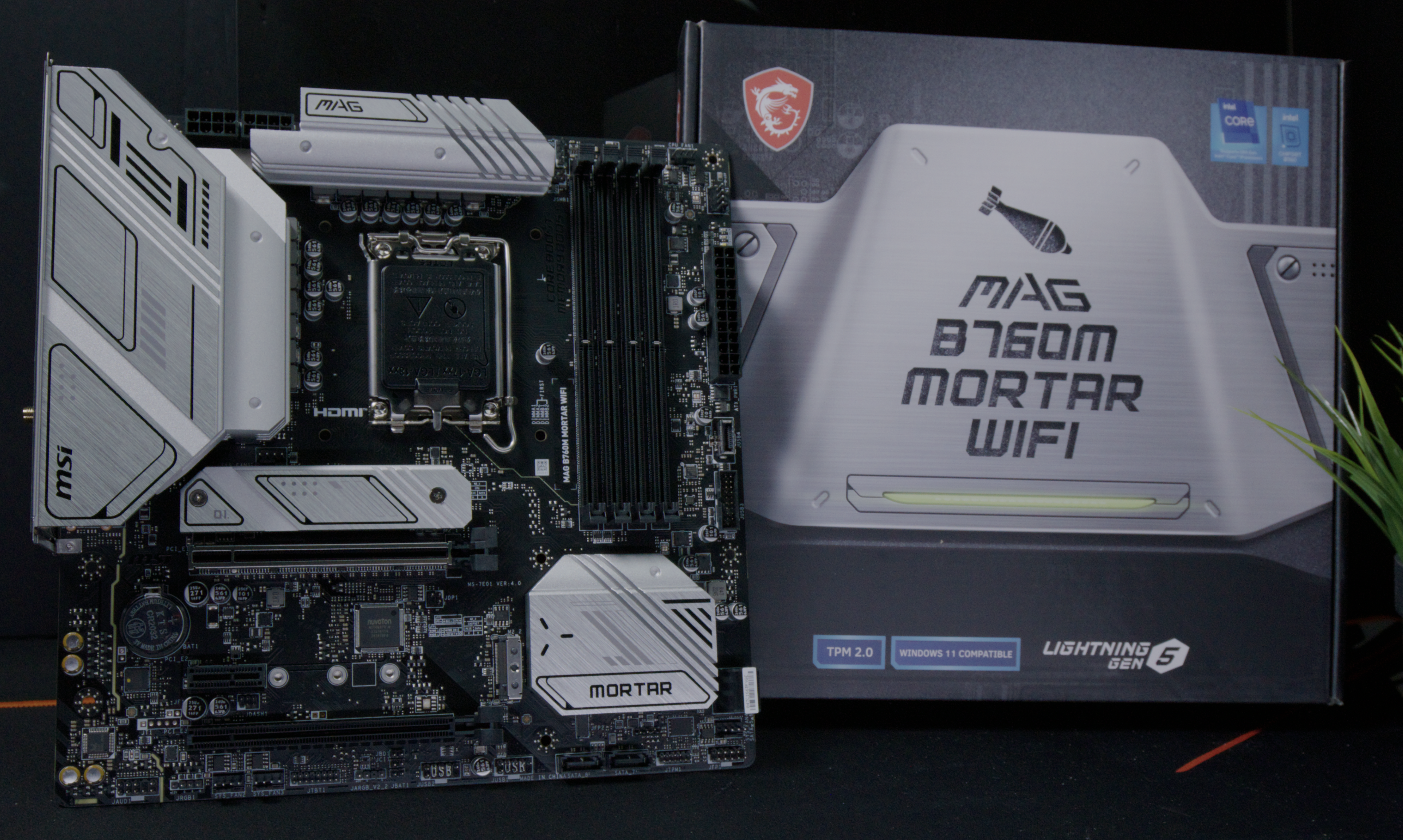
Pros
Good balance of features for a $199 Micro-ATX motherboard Two onboard M.2 slots, eight USB ports Nice networking and decent audio Clean design, integrated I/O shield
Cons
B760 means no CPU overclocking The four USB 2.0 slots should be at least USB 3.0 No heat sink on the second NVME slot Price When Reviewed:$199.99Best Prices Today:$179.99 at Walmart$199.99 at Amazon
If you want to save some more cash while going Micro-ATX and still pack a punch, the MSI MAG B760M Mortar WiFi is just the ticket. With an MSRP of $199, it will have some tradeoffs—the same B760 chipset limits noted above, such as lack of overclocking, and less VRM grunt as well.
You do get 12+1+1 duet rail VRMs, so you’ll be ready for almost any Intel CPU. We recommend avoiding the overclockable K SKUs here to save some coin—you’ll do great with even the standard i9 13900. With its lower wattage, it can be a boon for small form-factor builds that may lack proper CPU cooling.
The increasingly mainstream DDR5 RAM is also supported, with faster and cheaper kits available as time goes on. You no longer have to hold onto DDR4 motherboards to save some cash, DDR5 is the trend going forward. You’ll also get 4 DIMM slots with a 128GB limit—better than Mini-ITX, which offers two slots and 64GB. (A good reason why those who run heavier RAM workloads should consider Micro-ATX for a workstation-style build.)
PCIe Gen 5 is mostly a marketing spec, with less real-world viability at this point in time. You’ll have the GPU 16x lane as PCIe Gen 5, but everything else is PCIe Gen 4. This includes the two onboard M.2 slots, which are more than adequate for most users.
The rest of the I/O is fine, with eight rear USB ports. Sure, you’re only getting up to 20Gb/s USB 3 speeds, but Thunderbolt 4 performance is much pricier than most would be willing to spend on. You do get four USB 2.0 ports, which is certainly a bit disappointing for those expecting USB 3. Rounding off the features are the networking inclusions, with the standard 2.5Gb LAN and Wi-Fi 6E with Bluetooth. Audio is fine here too, no issues to report for the price.
With plenty of PWM fan headers, RGB headers, and SATA ports. You’re in good company with more expensive ATX motherboards here at much less the typical cost.
Where you do save some money is in the smart design. No, it’s not cheap feeling—quite the contrary. The build quality is great, and form follows function with an aesthetically pleasing approach. You’re just not paying for fancy RGB effects or expensive OLED displays—which is welcomed to keep costs down.
The I/O shield is integrated, too! Not bad for $199. Our only minor design quibble is that the second M.2 slot isn’t covered by a thermal cover, something we’ve seen in previous generations of the Mortar.
Overall, the MSI B760M Mortar is a competent motherboard for those looking to stay under $200 and still have a good set of features. Overclockers won’t be impressed, but most users will still get usable performance out of this unit.
Read our full MSI MAG B760M Mortar WiFi review
Best small form-factor gaming motherboards for AMD
Asus ROG X670E Gene – Best premium AMD SFF board
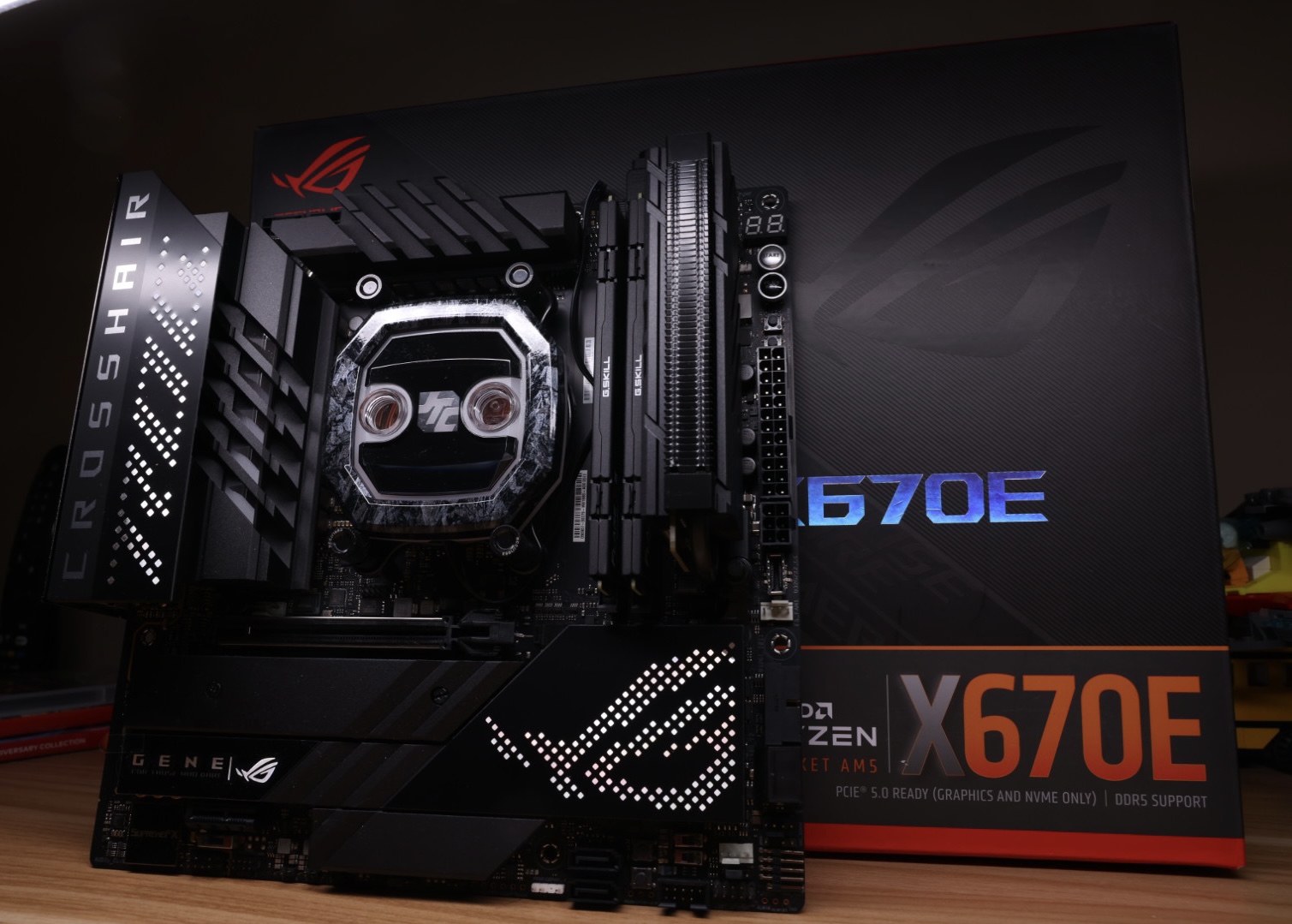
Pros
Stunning design and high build quality Included ROG Gen-Z.2 NVMe card Next gen features, DDR5, PCIe Gen 5 mATX will fit in smaller PC cases
Cons
Only two DIMM slots and some may find 64GB RAM limiting mATX limits such as one 16x slot, and one onboard NVMe $599 MSRP is bit high considering the specific use-case appeal Price When Reviewed:$599
Have you ever wanted to buy a big, beefy motherboard, like from the Asus “Extreme” lineup, but they were far too big? Fret no more, the Asus ROG X670E Gene brings a lot of that “over-the-top” goodness to a smaller Micro-ATX form factor. It’s also priced for the premium market—at $599, it’s one of the most expensive small form-factor motherboards we’ve encountered.
If you get over the sticker shock, you’ll be impressed with every facet of this motherboard. Performance is on par with any other high-end offering, with a 16+2 phase design for the VRMs. Indeed, the Ryzen 9 7950X or any of the X3D CPUs have met their match in this overachiever!
Performance perks continue with support for the fastest DDR5 RAM kits that AM5 offers. (Not as fast as Intel, but blazing speeds regardless.) One thing to keep in mind is that you’ll be limited to two DIMM slots, instead of the usual four on Micro-ATX motherboards. Technically, if you’re overclocking RAM or pushing the limits, it’s better to have fewer DIMM slots for maximum performance. That’s exactly what type of user will enjoy this motherboard the most! You’ll be able to keep everything cool with seven PWM fan headers, too.
PCIe Gen 5 is here too—and since this is the X670E chipset, it won’t skimp on PCIe lanes. The GPU 16x slot will give you PCIe Gen 5, plus an onboard M.2 Gen 5 slot. Don’t worry, you will get two additional M.2 slots on the included accessory, the ROG Gen-Z.2 card. One is PCIe Gen 5, and the second Gen 4—but that’s more than enough performance.
Performance metrics are visible everywhere, even in the I/O, where there’s USB4, with speeds up to 40Gb/s. That completes the 10 USB ports on the rear, an impressive number in both quantity and quality of ports. You even get a PS2 port for legacy devices, a feature aimed at overclockers.
Networking options are standard, with 2.5Gb LAN and Wi-Fi 6E with Bluetooth. This is just as expected, with cheaper motherboards offering similar. You’re not getting 10Gb LAN, however, an option we’d like to see on a motherboard of this caliber.
Audio is robust with a SupremeFX 7.1 ALC 4080 codec, enough for most users, save demanding audiophiles.
Aesthetically, the first thing you’ll notice when unboxing this gorgeous motherboard is the heft and sublime build quality. All parts of this motherboard feel extraordinarily premium, from materials to design aesthetics.
The design shows “ROG” DNA (Gene…) through and through, with beautiful RGB in various areas. If you value high build quality and enthusiast-grade aesthetics, you’ll fall in love with the Gene.
If the $599 price is acceptable to you, and Micro-ATX is your PC build/case objective, this is a mighty fine choice.
Read our full Asus ROG X670E Gene review
Asrock B650E PG-ITX – Best midrange AMD SFF board
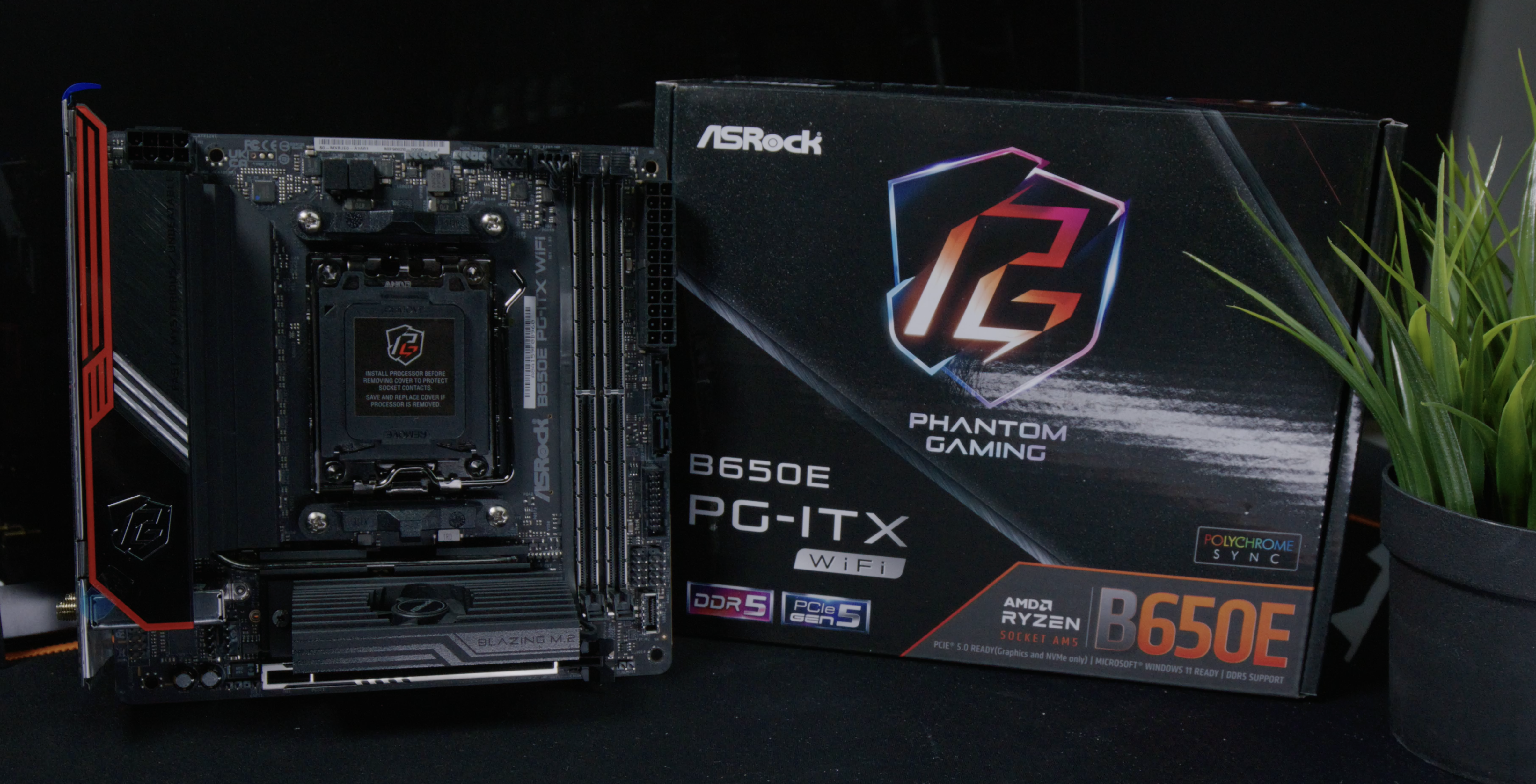
Pros
Good set of features for Mini-ITX Two onboard M.2 slots, including 1x PCIe Gen 5 Good networking and audio Capable VRMs
Cons
Noisy M.2 fan may interfere with some builds USB 2.0 ports should be upgraded $289 MSRP still high considering some limitations Price When Reviewed:$349.99Best Prices Today:$289.99 at Amazon$289.99 at Walmart
If premium AM5 offerings are too spendy for you, we don’t blame you. With higher-than-ever platform costs, it’s important to save some cash when you can while getting top-notch performance. That’s where the Asrock B650E PG-ITX comes in. With an MSRP of $289, it’s by no means cheap—but you get a well-rounded performer.
The board is wrapped in the B650E chipset—the “E” gives us some PCIe Gen 5 lanes that the standard B650 won’t have. This means that one of the two onboard NVMe slots can be Gen 5—a great option for those who like to be on the bleeding edge. You’ll also have the PCIe 16x slot at Gen 5, even though GPUs currently can’t saturate that.
PCIe Gen 5 means you get to take advantage of everything AM5 has to offer, and it gets better: The beefy 10+2+1 phase-design VRMs have a whopping 10-layer PCB, more than normal. Translation: This little motherboard will handle any Ryzen CPU you throw at it, even the mighty Ryzen 9 7950X. We’re sure many gamers will want to pair this with the new 7800X3D, a fine choice for maximum gaming performance. You’ll just want to make sure your CPU cooler is up to task, as this chips can get spicy-hot. Thankfully, the clever design of this motherboard leaves some nice room for most CPU coolers to fit.
Performance perks continue with DDR5, and the usual limit of two DIMM slots on Mini-ITX at 64GB. One area that the specs falter slightly is in the rear I/O. While you do get eight USB ports, four of them are only USB 2.0, which is a bit ancient at this point. You also don’t get USB4 like on the pricier Mini-ITX motherboards, so speeds will be closer to 20Gb/s USB 3 instead. That should be fine for most gamers, but at $289, we feel the USB implementation should be a bit better.
The design aesthetics of this motherboard are interesting, starting with the unusual M.2 fan. While it may look more like a VRM heatsink, this is certainly a larger-than-expected fan design, which may be hit-or-miss for some. Aside from that, it looks sharp. Functional design such as the integrated I/O shield and easy-to-use M.2 slots are great to see.
Despite the compromises inherent to a Mini-ITX motherboard, you’re still getting a great companion for fast Ryzen CPUs while saving some cash compared to more expensive offerings.
Read our full Asrock B650E PG-ITX review
MSI MAG B650M Mortar WiFi – Best bang-for-buck AMD SFF board
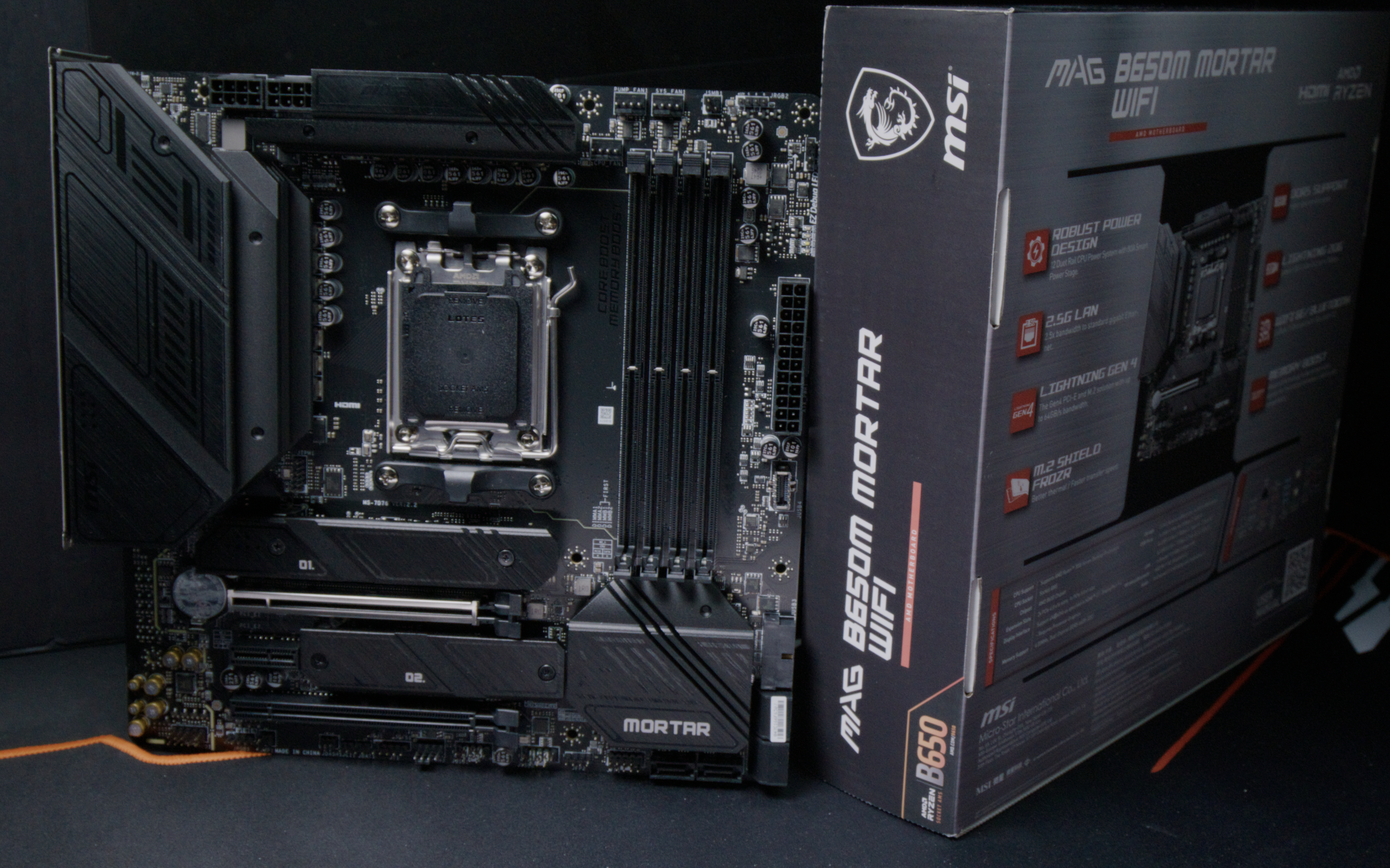
Pros
Great set of features for Micro-ATX at $239 Two onboard M.2 slots, 20Gb/s USB, PCIe Gen 4 Solid networking and decent audio Clean design looks great, includes integrated I/O shield
Cons
Users who need more M.2 NVMe slots will be limited No PCIe Gen 5, so AM5 CPUs don’t get full capabilities Not as many Micro-ATX cases available, niche market Price When Reviewed:$239.99Best Prices Today:$199.95 at Amazon$239.99 at B&H Photo$239.99 at Newegg
While the $239 price is far from budget—we’ll have to wait for the A620 motherboards for that—the MSI MAG B650M Mortar WiFi still delivers great value. With a Micro-ATX form factor, it’s a good mix of performance and features without leaving out anything essential.
It’s the standard B650 chipset, meaning you won’t have PCIe Gen 5, but Gen 4 more than suffices here. Both onboard M.2 slots will be more than snappy, and GPUs can’t currently utilize more than PCIe Gen 4. Performance is great, with VRMs packing a 12+2+1 duet rail system. This will make a perfect pairing for one of the standard Ryzen CPUs such as the 7700, or even works well with the zippy 7800X3D. While you’re not getting the top-tier performance of X670E VRMs, you should be within a few percentage points. DDR5 completes the package, with fast speeds and an available four DIMM slots. This will be an advantage over Mini-ITX, plus you’ll get a higher 128GB limit.
You also get multiple PCIe slots, another clear advantage over Mini-ITX. This is useful for those needing to add some extra “add-in” cards, with an available 4x and 1x slot in combination with the GPU 16x slot.
Showcasing the well-rounded nature of this motherboard, you’ll have plenty of USB ports on the rear, including 20Gb/s USB 3.2. Networking offers the complete 2.5Gb LAN with Wi-Fi 6E. Audio is also good, with a 7.1 ALC 4080 codec and plenty of inputs.
The aesthetics and design are simple, but effective. You’re not getting RGB or crazy displays, but the motherboard looks and feels well built. With a classic, straightforward design indicative of other MSI “MAG” motherboards, it will fit into almost any build theme. Plus, the integrated I/O shield is a great feature that adds to the build experience here.
While its $239 price is far from budget, the value is still here for what you’re getting. Combine that with a smaller Micro-ATX package, and it has most of the features and performance of ATX motherboards while staying within a reasonable price class.
Read our full MSI MAG B650M Mortar WiFi review
What to look for in a small form-factor gaming motherboard
Choosing a small form-factor motherboard often has the same line of questions as the larger offerings, but with a few very special additions that are vital to the experience. We’re dealing with smaller units here, meaning they can fit in much smaller PC cases, and generally will have less features than their larger counterparts. The goal is to find the best blend of value, performance, and features for the size you need.
Choose your platform: Intel or AMD
Intel or AMD will be an important decision. For small form-factor motherboards, you may want to aim at a CPU option that can still perform very well, but perhaps not tax the power and cooling requirements nearly as much.
Since you’re typically dealing with small enclosures that may not be able to handle 360mm radiators, some of the overclockable CPUs such as the Intel i9 13900K or the AMD Ryzen 9 7950X may run a bit hot for most builds.
Thankfully, both brands offer tamer CPUs that have less power output and heat, such as Intel’s Core i7-13700 or AMD’s Ryzen 7700.
Plan the size and hardware you want to use in advance
Small form factor requires a bit of extra planning, so you’ll want to choose the size very early on. Mini-ITX motherboards can fit literally anywhere, as most cases will have the standoff screw alignments for them. Small cases can be a tight fit, so you may even want to consider shorter custom power supply cables to make sure it neatly fits without obstruction.
Hardware choice is also important to consider: Intel will give you a choice of DDR4 or DDR5 RAM, depending on the motherboard you choose, so be aware of this. AMD AM5 is DDR5 only, so you’ll need to pick up a new RAM kit.
PCIe slots and lanes also vary, even with small form-factor motherboards. Mini-ITX will only give you one 16x slot typically, which may be PCIe Gen 5 or Gen 4. PCIe Gen 5 lane distribution can also vary, with X670E usually having the best options. This will typically affect whether the top NVMe slot can be PCIe Gen 5 or Gen 4, but it’s not a big deal in most use cases.
Know the features you need the most
Features can also be very different on some smaller motherboards due to size, combined with certain chipset limitations. You may not want to pay extra for some features that you’ll never use, such as Thunderbolt 4.
Most small offerings will still have a good set of USB and I/O, and Wi-Fi has been mostly standard. Keep in mind, though, that some cheaper motherboards do omit Wi-Fi, so it’s important to go over the specs to make sure.
Price to performance matters, even with small motherboards
Prices for motherboards have increased this generation, and small form factor is no exception. You’ll typically pay more for smaller boards with comparable features compared to ATX.
There are many benefits to a small build, such as saving space. It’s also very satisfying fitting powerful hardware in a small enclosure, and having it perform well. Just keep price in mind—sometimes the most expensive CPUs may not run as well due to the cooling limitations of smaller enclosures, so a cheaper option may be more optimal.
How we evaluate small form-factor gaming motherboards
As mentioned above, there are particular areas you need to be mindful of with a small form-factor gaming motherboard. The following is an overview of our evaluation process.
Specs and features
Are you getting essential features, such as networking, M.2 support, and ample I/O options for the price? Small motherboards tend to have fewer features than their big ATX counterparts, so we need to find the right balance.
Design
Sure, your tiny motherboard may be hidden behind cables in a small enclosure. Does it still have interesting design elements that are aesthetically appealing, and have some function? Items such as quick-release GPU PCIe slots, easy access to M.2 slots, etc. make a big difference to builders.
Performance
Just because you’re going small on size, doesn’t mean that you need to give up performance. Can this motherboard’s VRMs and next-gen tech, such as DDR5, keep pace with ATX motherboards without much compromise?
Value
Are some of the restrictions on specs worth the decrease in footprint? Do you get the right features for the price? More importantly, the small size has to provide more value to you then it takes away in performance or features.
FAQ
1.
Are small form-factor gaming motherboards worth it?
Small motherboards are unique—because they allow you to do any size build that you wish. Some enclosures can be as small as a standard console such as the Sony PS5, but pack a tremendous amount of power for the size. While you’ll typically pay more to put a small build together, it has a lot of payoff. Keep in mind, hardware options may be more limited, and special cooling considerations are also needed.
2.
How much RAM is needed for gaming?
Mini-ITX motherboards support two DIMM slots and 64GB of RAM, which is usually more than enough for any gaming build. 16GB is the minimum for a smooth experience, but games lately are using up to 32GB, so that may not be a bad idea going forward.
Micro-ATX will give you four RAM slots, something to consider if you want up to 128GB of capacity instead.
3.
Is DDR5 worth it?
DDR4 is still available on Intel 13th-generation motherboards, so it gives you some cheaper options and flexibility to use your own kit. We’d prefer DDR5 if possible, and AMD AM5 gives you DDR5 only.
DDR5 availability and costs have improved recently, so options are much better and we’d recommend going for it if you can.
4.
What is the typical lifespan of a small form-factor gaming motherboard?
Due to them having fewer features on board, small form-factor motherboards may have a slightly shorter life span than a larger motherboard. You’ll also typically get fewer PCIe slots, NVMe slots, and other I/O, so if you ever need to expand, you will be limited.
You also need to be aware of case sizes and fitting larger GPUs—graphics cards have gotten considerably larger and may continue to do so in the future. That’s one consideration tied to case size, although you could always put a small motherboard in a larger case. (It might just look aesthetically too small, and it might lack some features of other ATX.)
Otherwise, if you get a well-built, quality motherboard, it should physically last a good amount of time—just make sure you have proper ventilation and cooling, especially in a small enclosure.
Author: Thiago Trevisan
Recent stories by Thiago Trevisan:
I’m a longtime PC builder, but this boutique PC taught me a few lessonsAsus ROG Strix Z790-I Gaming WiFi review: A Mini-ITX board for enthusiastsAsus ROG Strix B760-I Gaming WiFi review: Potent, small, and colorful






